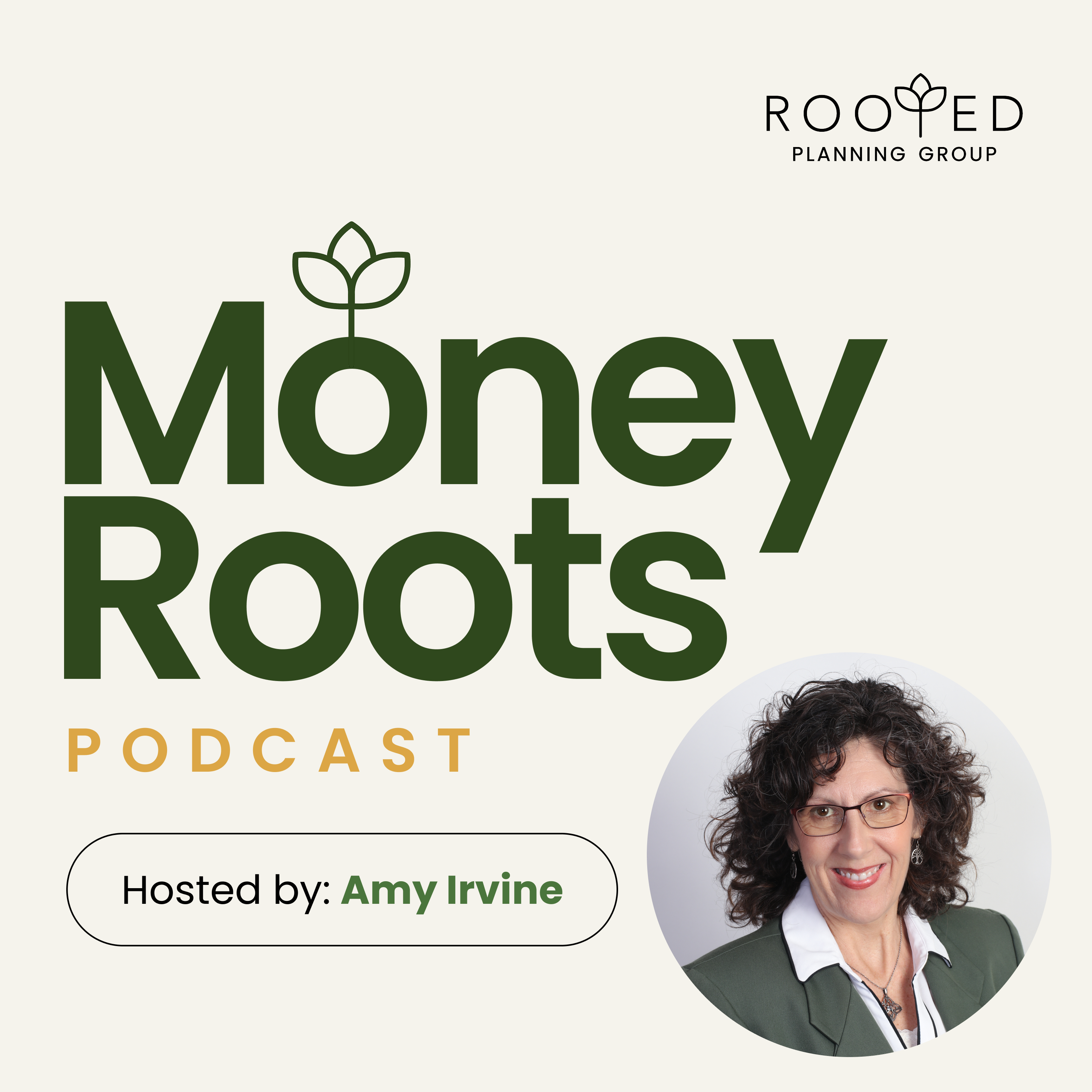Economics 101: Understanding CPI, Unemployment, and Consumer Sentiment
Welcome to another exciting episode of Wine and Dime with your host, Amy Irvine! In this episode, we'll not only dive deep into the world of economics, but also embark on a delightful exploration of the Virginia wine region. Get ready to learn about the state's rich history of wine production, the unique varietals it offers, and the beautiful landscapes where these grapes flourish. So, pour yourself a glass of your favorite Virginia wine, sit back, and join Amy as she uncorks a wealth of knowledge about both CPI and unemployment, as well as the fascinating world of Virginia's wine industry. Cheers!
Don't miss out on valuable insights and empowering financial advice! Subscribe to "Money Roots" today to embark on a journey of financial growth and empowerment. Join host Amy Irvine as she simplifies personal finance, making it accessible to everyone, from beginners to seasoned experts. By subscribing, you'll stay up-to-date with each episode, gaining access to practical tips, inspiring stories, and expert insights that will help you take control of your financial future. Whether you're looking to budget smarter, invest wisely, or secure your retirement, "Money Roots" has something for everyone. Subscribe now and start nurturing your financial well-being!
If you have any questions that you would like answered on the show, feel free to email us at info@rootedpg.com
Or visit us at www.rootedpg.com/podcasts for full show notes and links!
Episode Summary:
In today's episode, Amy Irvine explores the connection between economic indicators like the Consumer Price Index (CPI) and unemployment, and how they influence consumer sentiment. As Amy breaks down the complexity of CPI, she highlights its various components and how they relate to inflation.
The discussion then moves on to the relationship between unemployment and inflation, with Amy explaining the significance of the U3 and U6 unemployment rates. She emphasizes the importance of monitoring these rates to understand their potential impact on the economy.
Lastly, Amy delves into the connection between consumer and investment sentiment, explaining the importance of consumer sentiment as an economic indicator. By understanding consumer sentiment, we can better grasp how it affects spending and overall GDP.
Don't miss out on this informative episode that sheds light on the complex relationships between economic indicators and consumer behavior. And if you haven't already, make sure to listen to the previous episodes in this six-part series to get a comprehensive understanding of the economy and its impact on our daily lives.
Virginia is for Wine Lovers:
In this episode, host Amy Irvine takes a detour from the economic discussion to share her passion for wine, specifically exploring the wine industry in Virginia. She reveals that wine production in the state dates back to the early days of European colonization in the 17th century. Despite the hot and humid summers that can pose a challenge to viticulture, the Virginia wine industry has grown significantly in the last 20 years.
Amy highlights that French hybrid varieties account for about 20% of the total grape production in Virginia, while American varietals make up approximately 5%. She shares the top ten varietals produced in the region, such as Chardonnay, Cabernet Franc, Merlot, and Viognier. Amy also notes that the central and northern Virginia County area, particularly just east of the Blue Ridge Mountains, is responsible for a significant portion of the state's wine production.
Amy's enthusiasm for the Virginia wine industry is evident as she expresses her desire to visit and explore the region in person, and she encourages listeners to share their recommendations for great Virginia wines that she could try and potentially feature on the show in the future.
This episode is brought to you by Rooted Planning Group. Rooted Planning Group is a fee-only financial planning firm that specializes in working with women in their 30s and 40s who want to take control of their finances and plan for the future. Whether you're just starting out or you're looking to make a big change, Rooted Planning Group can help.
Visit www.rootedpg.com to learn more.
Transcript
[0:00:27] Amy Irvine: Part two, we talked about understanding economic indicators like the Leading Economic Index and the Institute for Supply Management. In part three, we talked about gross domestic product or GDP and what that actually means. And then again, as I mentioned, today we're going to be talking about CPI and unemployment. Now, before we get into that, I have to remind you that I am exploring different areas of the United States. I figured since I was talking about economy, I should stay with a local economy here.
[:[0:01:30] Amy Irvine: But here's what I learned when I was researching that region. So the wine produced in Virginia has been there since the early days of European colonization in the 17th century. Virginia has a hot, humid summer that can be challenging to viticulture, and only within the last 20 years has the industry developed beyond novelty status. And one of the things that I read about was that French hybrids varieties account for about 20% of the total grape production in that area, while American varietals make up about 5% of the total.
[:[0:02:40] Amy Irvine: The other area that it's kind of central and northern Virginia County is particularly just east of the Blue Ridge Mountains. That accounts for a significant majority of their production. So I love that area. It's on my list now. It's certainly when I go to the local wine shops. I'm going to be looking for that region and see if I can't find something. And if you as a listener know of a great wine coming out of Virginia, please send me a note. I'd love to taste it and maybe even feature it on the show in the future.
[:[0:03:41] Amy Irvine: A measure of the average change over time in prices paid by Urban Consumers for a market basket of consumer goods and services. Now Urban is thrown in there, by the way. So that is the definition. And a piece of the change over time is certainly inflation and consumer demand. Consumers demand higher income to offset those higher prices. What's interesting about CPI that a lot of people I think don't realize is that there are various components of CPI. So if we actually break it down, there's transportation services, there's food, there's shelter, there's new vehicles, there's Core CPI, and then there's CPI. And then we look at medical care and commodities, we look at apparel, we look at medical care services, energy and used cars. So there's a whole bunch of different consumer Price Index components. When we're thinking about CPI, it's not just one piece of it. We look personally at current levels, troughs and peaks within the past twelve months for the CPI components, headline CPA and core CPA. So we've seen most areas decline from their peaks.
[:[0:05:33] Amy Irvine: Most everything on the charts that we follow except shelter is below its peak. Shelter has stayed right about at the same level. So it really hasn't gone down at this stage of the game. So that's the one component that hasn't changed much. But then what about when? So we know all of that and job market has been strong and certainly lately there's been some layoffs. But what about when unemployment strikes? Well, there is a relationship between unemployment and inflation.
[:[0:06:43] Amy Irvine: In other words, it's rising. Side note for those of you that are like what's the U three employment rate? U three is the most it's the official unemployment rate. The U six unemployment rate includes everyone not accounted for in U three. Like discouraged underemployed and unemployed workers in the country that have been beyond the unemployment program. So this particular chart that I look at follows U three, which like I said, is the the widest looking back over the last 38 years and the last four recessions, we see unemployment rising just before a recession and that's why it's important for us to follow it. Currently we are seeing a slight uptick in those that are unemployed for 27 weeks or over and a slight downtick in those that are employed 15 to 26 weeks. That could be because those folks that have been employed that long are now flopping into that 27 week.
[:[0:08:13] Amy Irvine: I think it's important also to understand the difference between the two. Now, today I am just going to be talking about consumer sentiment, but tune in for part five because I will be talking about investor sentiment in part five when we follow the charts that we follow. They report the three measures of consumer sentiment from a survey collected by the University of Michigan. The indices for sentiment are current conditions and expectations. So when we think about the different sentiments that we are considering it's the index of current economic conditions is constructed from questions regarding individuals financial well being relative to a year ago and the individual's perception timing of a large purchase for their home, such as an appliance. The index of the current economic indicator is derived from expectations for individuals financial situation in one year, expectations for the country as a whole for one year, and expectations or volatility in the next five years. And then the index of the consumer sentiment is derived from all of the components of the current economic condition and the current economic conditions that are derived from what they call the ice and the ICC, right? So we're looking at both, all of those.
[:[0:10:12] Amy Irvine: Currently, consumer sentiment is well below the average since 1980, but not as low as it was just a few months ago, which by the way, got as low as it was in the 2008 and 2009. So sentiment got pretty weak earlier. So I think it's important. Again, I just want to go through super quick because I don't want to repeat myself too much, but when we're talking about consumer sentiment, we follow a chart that reports three measures of consumer sentiment from surveys from that University of Michigan. Just to clarify, they are indices for sentiment, current condition and expectations.
[:[0:11:18] Amy Irvine: So you can see the difference. And then, like I said, the index of consumer sentiment is actually derived from both of those components. So I know that was a little bit longer than what the rest of the series has been, but I hope that you enjoyed this podcast and if there's other areas that you'd like me to explore so that you have more information and we'd love to provide that. Thank you for listening to today's show.
[:

